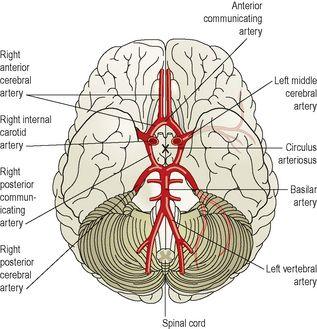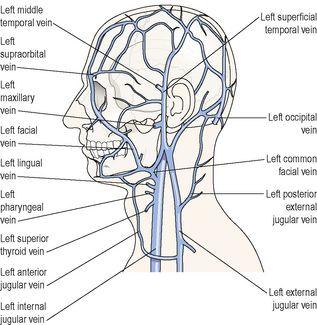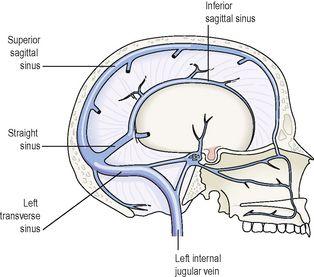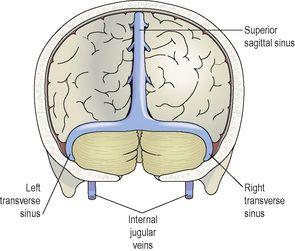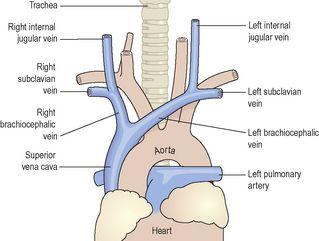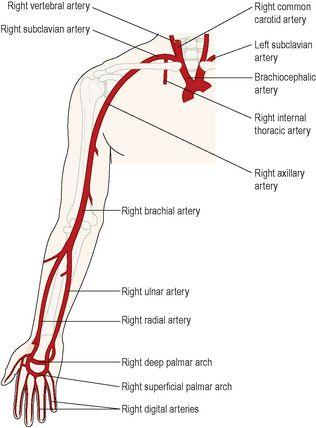Ross & Wilson Anatomy and Physiology in Health and Illness (46 page)
Read Ross & Wilson Anatomy and Physiology in Health and Illness Online
Authors: Anne Waugh,Allison Grant
Tags: #Medical, #Nursing, #General, #Anatomy

•
The
maxillary artery
supplies the muscles of mastication and a branch of this artery, the
middle meningeal artery
, runs deeply to supply structures in the interior of the skull.
Internal carotid artery
This is a major contributor to the circulus arteriosus (circle of Willis) (
Fig. 5.33
), which supplies the greater part of the brain. It also has branches that supply the eyes, forehead and nose. It ascends to the base of the skull and passes through the carotid foramen in the temporal bone.
Figure 5.33
Arteries forming the circulus arteriosus (circle of Willis) and its main branches to the brain.
Circulus arteriosus (circle of Willis)
The greater part of the brain is supplied with arterial blood by an arrangement of arteries called the
circulus arteriosus
or the
circle of Willis
(
Fig. 5.33
). Four large arteries contribute to its formation: the two
internal carotid arteries
and the two
vertebral arteries
(
Fig. 5.34
). The vertebral arteries arise from the subclavian arteries, pass upwards through the foramina in the transverse processes of the cervical vertebrae, enter the skull through the foramen magnum, then join to form the
basilar artery
. The arrangement in the circulus arteriosus is such that the brain as a whole receives an adequate blood supply when a contributing artery is damaged and during extreme movements of the head and neck.
Anteriorly, the two
anterior cerebral arteries
arise from the internal carotid arteries and are joined by the anterior
communicating artery
.
Posteriorly, the two
vertebral arteries
join to form the basilar artery. After travelling for a short distance the
basilar artery
divides to form two
posterior cerebral arteries
, each of which is joined to the corresponding internal carotid artery by a
posterior communicating artery
, completing the circle. The circulus arteriosus is therefore formed by:
•
2 anterior cerebral arteries
•
2 internal carotid arteries
•
1 anterior communicating artery
•
2 posterior communicating arteries
•
2 posterior cerebral arteries
•
1 basilar artery.
From this circle, the
anterior cerebral arteries
pass forward to supply the anterior part of the brain, the
middle cerebral arteries
pass laterally to supply the sides of the brain, and the
posterior cerebral arteries
supply the posterior part of the brain.
Branches of the basilar artery supply parts of the brain stem.
Venous return from the head and neck
The venous blood from the head and neck is returned by
deep
and
superficial veins
.
Superficial veins with the same names as the branches of the external carotid artery return venous blood from the superficial structures of the face and scalp and unite to form the external jugular vein (
Fig. 5.35
).
Figure 5.35
Veins of the left side of the head and neck.
The
external jugular vein
begins in the neck at the level of the angle of the jaw. It passes downwards in front of the sternocleidomastoid muscle, then behind the clavicle before entering the
subclavian vein
.
The venous blood from the deep areas of the brain is collected into channels called the
dural venous sinuses
.
The dural venous sinuses of the brain (
Figs 5.36
and
5.37
) are formed by layers of dura mater lined with endothelium. The dura mater is the outer protective covering of the brain (
p. 146
). The main venous sinuses are listed below:
•
The
superior sagittal sinus
carries the venous blood from the superior part of the brain. It begins in the frontal region and passes directly backwards in the midline of the skull to the occipital region where it turns to the right side and continues as the
right transverse sinus
.
•
The
inferior sagittal sinus
lies deep within the brain and passes backwards to form the
straight sinus
.
•
The
straight sinus
runs backwards and downwards to become the
left transverse sinus
.
•
The
transverse sinuses
begin in the occipital region. They run forward and medially in a curved groove of the skull, to become continuous with the
sigmoid sinuses
.
•
The
sigmoid sinuses
are a continuation of the transverse sinuses. Each curves downwards and medially and lies in a groove in the mastoid process of the temporal bone. Anteriorly only a thin plate of bone separates the sinus from the air cells in the mastoid process of the temporal bone. Inferiorly it continues as the internal jugular vein.
Figure 5.36
Venous sinuses of the brain viewed from the right.
Figure 5.37
Venous sinuses of the brain viewed from above.
The
internal jugular veins
begin at the jugular foramina in the middle cranial fossa and each is the continuation of a sigmoid sinus. They run downwards in the neck behind the sternocleidomastoid muscles. Behind the clavicle they unite with the
subclavian veins
, carrying blood from the upper limbs, to form the
brachiocephalic veins
.
The
brachiocephalic veins
are situated one on each side in the root of the neck. Each is formed by the union of the internal jugular and the subclavian veins. The left brachiocephalic vein is longer than the right and passes obliquely behind the manubrium of the sternum, where it joins the right brachiocephalic vein to form the
superior vena cava
(
Fig. 5.38
).
Figure 5.38
The superior vena cava and the veins that form it.
The
superior vena cava
, which drains all the venous blood from the head, neck and upper limbs, is about 7 cm long. It passes downwards along the right border of the sternum and ends in the right atrium of the heart.
Circulation of blood to the upper limb
Arterial supply
The subclavian arteries
The right subclavian artery arises from the brachiocephalic artery; the left branches from the arch of the aorta. They are slightly arched and pass behind the clavicles and over the first ribs before entering the axillae, where they continue as the
axillary arteries
(
Fig. 5.39
).
Figure 5.39
The main arteries of the right arm.
Before entering the axilla, each subclavian artery gives off two branches: the
vertebral artery
, which passes upwards to supply the brain, and the
internal thoracic artery
, which supplies the breast and a number of structures in the thoracic cavity.
The
axillary artery
is a continuation of the subclavian artery and lies in the axilla. The first part lies deeply; then it runs more superficially to become the
brachial artery
.
The
brachial artery
is a continuation of the axillary artery. It runs down the medial aspect of the upper arm, passes to the front of the elbow and extends to about 1 cm below the joint, where it divides into the
radial
and
ulnar arteries
.
The
radial artery
passes down the radial or lateral side of the forearm to the wrist. Just above the wrist it lies superficially and can be felt in front of the radius, as the radial pulse. The artery then passes between the first and second metacarpal bones and enters the palm of the hand.
